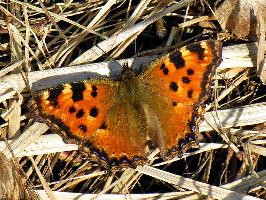
Váhy a míry
| Délka | od 50 do 55 mm |
|---|
Popis zvířete
The Large Tortoiseshell (Nymphalis polychloros) is a captivating butterfly species belonging to the Nymphalidae family, which encompasses a diverse range of colorful and striking butterflies. This species, characterized by its considerable size and attractive coloration, is a sight to behold in its natural habitat.Adult Large Tortoiseshells boast a wingspan ranging from 60 to 75 millimeters, making them a relatively large species within the Nymphalidae family. The upper side of their wings exhibits a rich tapestry of colors and patterns. The primary color is a deep, warm orange, which is beautifully contrasted with black markings. These include a series of black spots and lines that adorn the wings, adding to their intricate appearance. The wing edges are bordered with a black band that contains small blue spots within it, giving the butterfly an even more distinguished look. The underside of the wings mirrors the complexity of the upper side but with a more subdued color palette, featuring shades of brown and gray that help the butterfly camouflage itself against the bark of trees and other natural backgrounds when at rest.
The Large Tortoiseshell is a temperate species, predominantly found across Europe and Asia. Its distribution extends from Western Europe through to the temperate regions of Asia, including the Himalayas. The habitat of this butterfly is quite varied; it thrives in woodland areas, forest edges, and even in well-vegetated gardens and parks. These environments provide the necessary resources for its survival, including the larval host plants like various species of elm (Ulmus), willow (Salix), and birch (Betula), on which the caterpillars feed.
The life cycle of the Large Tortoiseshell encompasses several stages, starting from egg to caterpillar, pupa, and finally, the adult butterfly. The females lay their eggs in clusters on the underside of leaves of the host plants. Upon hatching, the caterpillars are gregarious and feed together on the leaves, making them easier to spot. As they grow, they become more solitary. The caterpillar is predominantly black with spiny protrusions and white or yellowish spots along its sides, designed for defense and camouflage. After completing the larval stage, the caterpillar forms a chrysalis where it undergoes metamorphosis, emerging as an adult butterfly to continue the cycle.
The Large Tortoiseshell, while not considered globally threatened, has seen a decline in numbers in certain parts of its range, notably in the UK, where it has become a rarity and is thought to be extinct as a breeding species. Factors contributing to its decline include habitat loss, changes in agricultural practices, and climate change. Conservation efforts aimed at preserving its habitat and promoting biodiversity are crucial for the survival of this and many other species.
In summary, the Large Tortoiseshell butterfly is a remarkable species, not only for its aesthetic appeal but also for its interesting life cycle and the role it plays in the ecosystem. Its presence adds to the biodiversity of its habitat, making it a species of interest for conservationists and nature enthusiasts alike.
Podobná zvířata
Nové fotografie zvířat
Top 10 zvířat
- Dolphin gull (Leucophaeus scoresbii)
- Diana monkey (Cercopithecus diana)
- Stone loach (Barbatula barbatula)
- Japanese macaque (Macaca fuscata)
- Greek tortoise (Testudo graeca)
- Moustached guenon (Cercopithecus cephus)
- Galápagos tortoise (Geochelone nigra complex)
- Russian tortoise (Testudo horsfieldii)
- Galápagos penguin (Spheniscus mendiculus)
- Common flying dragon (Draco volans)


